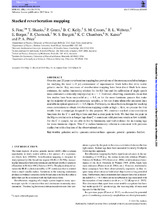Stacked reverberation mapping
Date
2013Author
Fine, Stephen
Shanks, T.
Green, P.
Kelly, B.
Croom, S. M.
Webster, R. L.
Berger, E.
Chornock, R.
Burgett, W. S.
Chambers, K. C.
Kaiser, N.
Price, P. A.
Metadata
Show full item recordAbstract
Over the past 20 years reverberation mapping has proved one of the most successful techniques
for studying the local (<1 pc) environment of supermassive black holes that drive active
galactic nuclei. Key successes of reverberation mapping have been direct black hole mass
estimates, the radius–luminosity relation for the Hβ line and the calibration of single-epoch
mass estimators commonly employed up to z ∼ 7. However, observing constraints mean that
few studies have been successful at z > 0.1, or for the more-luminous quasars that make
up the majority of current spectroscopic samples, or for rest-frame ultraviolet emission lines
available in optical spectra ofz>0.5 objects. Previously,we described a technique for stacking
cross-correlations to obtain reverberation mapping results at high z. Here, we present the first
results from a campaign designed for this purpose. We construct stacked cross-correlation
functions for the C IV and Mg II lines and find a clear peak in both. We find that the peak in
the Mg II correlation is at longer lags than C IV consistent with previous results at low redshift.
For the C IV sample, we are able to bin by luminosity and find evidence for increasing lags
for more-luminous objects. This C IV radius–luminosity relation is consistent with previous
studies but with a fraction of the observational cost.

